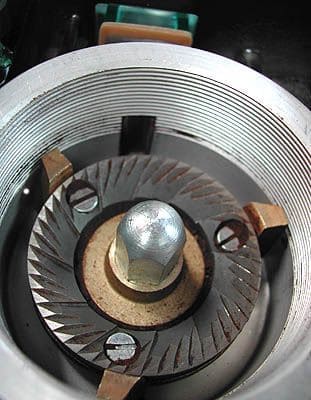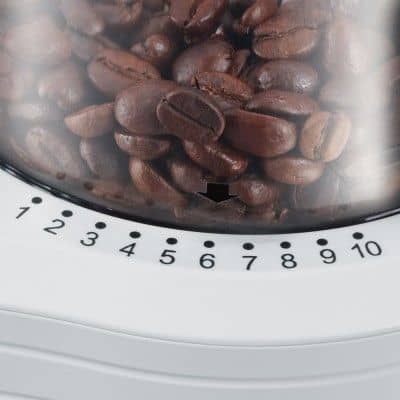Many users choose to grind their coffee themselves, despite the wide variety of ground coffees and blends sold today in supermarkets and speciality shops. What’s the point? Why waste time and money on a process you can already buy done?
Well, it’s very simple: the purity and freshness of freshly ground coffee are unbeatable, no matter how perfect the packaging system they sell us. Coffee, once ground, releases various gases and therefore cannot be packaged immediately. This obligatory waiting time causes packaged ground coffee to lose properties and nuances concerning the original freshly ground coffee.
You will never appreciate the same nuances and aromas in your coffee as when you have just ground it. Be clear about this. So, to situate ourselves, let’s never forget this maxim: the process of grinding is fundamental and critical in the final quality of the coffee we are going to prepare.
When choosing the most suitable coffee grinder for your home, you should be clear about several things. On the one hand, what types of grinders there are and, on the other hand, what kind of grinder you need to get to prepare the coffees in your house. It is not an easy task, especially if we are going to buy our first grinder, so we have thought of preparing this buying guide to help you choose the most suitable grinder for your needs.
What types of coffee grinders are there?
If you want to know more about the different types of coffee grinders, we explain them all in more detail in our guide about coffee grinders. Here we will only make a summary. We can roughly determine three types of grinders:
- Blade grinders: these are cheaper and faster than grinders, but in general, they are not the most recommended for grinding coffee. The blades destroy the grains (they don’t grind them), they don’t allow to define with procession the thickness of the grinding, and besides, we have to operate them carefully because the blades can be reheated quickly, and end up affecting the flavour of the coffee. It’s worth spending a little more and buying a grinder unless we don’t have any demands on the quality of the grinding.
- Electric grinders: The grinders (which can be of two types, flat or conical) press and grind the coffee beans evenly. Besides, they allow you to select the exact thickness of the grinding, either finer or fatter, which is fundamental since, as we will see, each type of coffee requires a different grinding thickness. The electric grinders start the grinders through a switch, which we will stop when we feel like it. They are more precise, and they reheat much less than those with blades. They are also more expensive, of course, although if you look hard enough, you can do with an excellent electric grinder for little money or a second-hand grinder. The market for second-hand coffee grinders is very active, as they are products of extraordinary durability.
- Hand grinders: The grinders work the same as electric grinders, but instead of having a motor, we have to operate them manually by turning a crank. They are more handmade but also slower than electric grinders.
A grinding wheel system, if we look at it from above, looks more or less like this:

What you see in the picture is the lower millstone. The upper grinding wheel has been removed for cleaning (so we can see something in the picture).
Apart from this primary division, the grinders are further subdivided into more groups according to the components they include. Thus, we can find flat or conical grinding mills, mills with or without dosing devices, etc. The material of the grinders is also essential: stainless steel grinders will always be more durable and will heat up less than aluminium ones.
As you can see, the problem of overheating is a recurring one. We must avoid it at all costs, as it not only puts the durability of our coffee grinder at risk but also affects the final taste of our drink (pro-coffee makers are much more concerned with the latter than with the former).
In short, choose the grinder according to your needs and your budget (you can always look at the list of cheap grinders), always considering the guidelines we have explained in this article. If you want to know more about the different types of grinders, we insist, have a look here.
Have you already chosen what kind of grinder you want? OK, now you must evaluate another parameter: what grind you will need for the coffees you will prepare.
When we talk about the thickness or fineness of the grinding, we talk about the thickness of the particles we obtain after grinding the coffee. Thus, we can refer to fine, ultrafine, medium, or coarse ground coffee, and there is none better than another. As we see in this article, a grind is needed for each type of coffee: types of grind, a thickness for each coffee. Roughly speaking, we can summarize it in the following list:
- Espresso machines need very fine ground coffee.
- Drip coffee makers need medium ground coffee.
- Italian or Moka coffee machines need a medium-fine grind. Never as fine as espresso.
- Piston coffee machines, or French presses, only work with coarse ground coffee.
How do I select the grind thickness for each use?
The grinders offer two methods to choose the grinding thickness: the manual method and the method with scales.
In the scale method, the grinder already includes a series of predefined degrees or scales, which unambiguously determine the grind we will obtain. For example, there are grinders with 9 degrees of grinding, with 12, with 15 or with 40. The more precise the grinder is, the more degrees of grinding it will offer us. Typically, grade 1 corresponds to the finest grinding, and the coarser grade corresponds to a coarser thickness.
Here is an example of an electric grinder with a 10 grade or thickness selector:

The manual method allows the user to determine the separation between the two grinder wheels (usually, the lower one is fixed, and the one we can move is the upper one). Of course, this method gives more freedom, but it requires the user to have much more control and knowledge about the machine he is using and the coffee he will brew afterwards.
Whichever thickness you choose, remember to make sure that the grinder will meet your expectations, especially on the finest levels. In other words, you may need an ultra-fine grind to make espresso, but then use the finest grade of your grinder, and it may not be fine enough – in some cases, the power of the grinder is essential! Of course, the most powerful grinders, capable of obtaining the finest grind, are also the most expensive.
So much for our tips on choosing a coffee grinder. We hope that they help you clear up any doubts that you may have when deciding to buy a coffee that is so important for the quality of your coffee.
Related: Which Coffee Maker Should I Buy?
